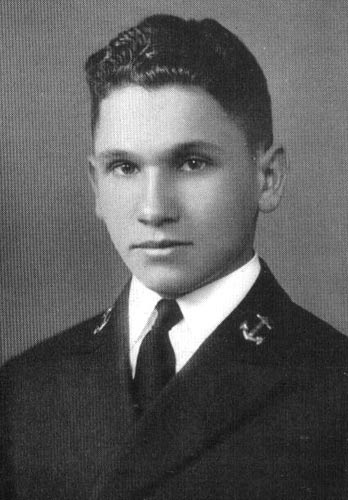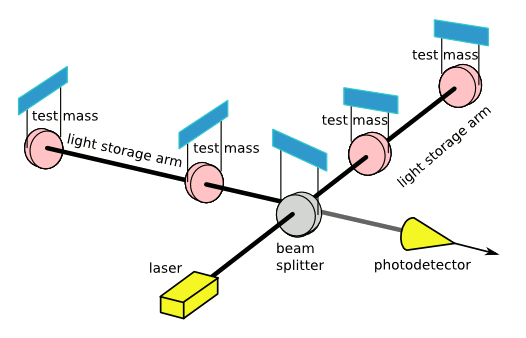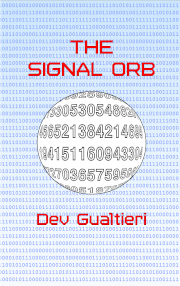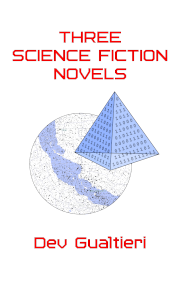Gravitational Waves
February 3, 2014
When I was a student in
junior high school, I read a popular account of
Einstein's theory of general relativity and the existence of
gravitational waves. Gravity, just like
radio, propagates as a
wave at the
speed of light. If the
mass of an object changes, a wave-like ripple in
spacetime signals that change to the rest of the
universe.
I had also read how rapid movement of a body increases its mass. In a childhood
eureka moment, I devised a
telegraph system in which changing the
rotational speed of a mass attached by a
lever arm to a
motor would generate
gravitational radiation that could be detected by some other device. At age twelve, I hadn't learned enough
physics to know how fast that motor would need to spin to produce even a minuscule gravitational wave.
As mentioned in some previous articles (
Entropic Gravity, October 26, 2010, and Big G, October 12, 2010), the force of gravity is very small. For example, the repulsive electrical force between two electrons is nearly 1043 times stronger than their gravitational attraction. This makes the measurement of gravitational force very difficult, and the detection of gravitational radiation nearly impossible.
Scientists, however, aren't usually dissuaded from doing impossible experiments. Modern technology has enabled many experiments that were thought impossible in the past. Since calculation shows that the laboratory creation of observable gravitational waves is not presently possible, experiments have focused on the detection of gravitational radiation from cosmological sources. These sources would be objects with large accelerations, or large quadrupole moments, such as binary star systems of neutron stars, white dwarfs, or black holes.
There is indirect evidence of the existence of gravitational radiation from astronomical observation. Russell Alan Hulse and Joseph Hooton Taylor, Jr., were awarded the 1993 Nobel Prize in Physics for the first such discovery. They discovered the binary pulsar, PSR B1913+16, which is a pulsar with a 59 millisecond period associated with a dark companion star. Precise measurements of this system showed that the orbit of these objects is contracting because of energy loss from gravitational wave emission in a way that corresponds to Einstein's predictions within 0.3%.
Gravitational waves can be detected by monitoring the change in the size of an object with its passage. Such a change is exceedingly small, so the first such detector, built in the 1960s by Joseph Weber (1919-2000) of the University of Maryland relied on resonant detection. Weber's detector, called a Weber bar, was an aluminum cylinder that would resonate at 1660 Hz when excited by a gravitational wave.[1-6]
Although this cylinder was quite large (a meter in length and two meters in diameter), the expected dimensional change was calculated to be only 10-16 meters, about the diameter of a proton. As could be expected, it was hard to extract signals from noise, and Weber could not convince most physicists that he had detected any such waves, although there was a coincidence with the supernova, SN 1987A, in 1987. IBM physicist, Richard Garwin, whom I wrote about in a previous article (Richard Garwin, January 10, 2014), essentially duplicated Weber's detector. He found just one pulse in six months, and that pulse was not much distinguished from noise.

Gravitational wave physicist, Joseph Weber, as he appeared in his United States Naval Academy yearbook.
Weber served in the US Navy during World War II as commander of several different ships. An electrical engineer by training, Weber was head of the US Navy Bureau of Ships electronic countermeasures department from 1945-1948, becoming a professor at the University of Maryland (College Park) in 1948.
(Via Wikimedia Commons.)
Weber even looked for coincident events from two such detectors, one at the University of Maryland, and the other about a thousand kilometers distant at Argonne National Laboratory, to rule out noise from electromagnetic and seismic sources.[4] Still, physicists were never convinced that he had seen an unambiguous gravitational wave event.
The failures of these early attempts have not dissuaded others from trying for detection using more sensitive devices. Peter Aufmuth and Karsten Danzmann of the Max-Planck-Institut für Gravitationsphysik (Hannover, Germany) published a paper several years ago reviewing gravitational wave detectors in the New Journal of Physics.[7] This paper, which is one of the most read at that journal and a good tutorial on this topic, is freely available online.[8]
One modern approach to gravitational wave detection is using the Earth itself as a detector. There are radio observatories worldwide which are capable of detecting the signals of millisecond pulsars with high period accuracy. A gravitational wave will cause the Earth to shrink in one direction, and expand in another. A careful measurement in pulsar timing could reveal gravitational radiation from the merger of a pair of supermassive black holes.
Since the merger of supermassive black holes is probably a very rare event, laser interferometers are more promising detectors. Light signals bounced from suspended masses separated by large distances are combined to reveal very small changes in their positions (see figure). The large distance increases sensitivity, and the masses will respond to excitations over a wide range of frequencies. In one such detector, LIGO (Laser Interferometer Gravitational Wave Observatory), a strong gravitational wave would change the distance between masses by about 10-18 meters, and the detection limit is about 10-22 meters, which is about six orders of magnitude better than Weber's bars.

A schematic diagram of LIGO, the Laser Interferometer Gravitational Wave Observatory. There are actually three LIGO gravitational wave detectors, one located in Livingston, Louisiana, and the other two in Richland, Washington. The storage arms are situated in vacuum tubes 2-4 kilometers in length. A gravitational wave will stretch/contract the two arms unequally. (Modified Wikimedia Commons image.)
Space-based interferometers have some advantages over their ground-based counterparts. Space is a nice vacuum, and the test masses can the separated by very large distances without additional expense. These test masses are also isolated from seismic noise. One such interferometer design, LISA (Laser Interferometer Space Antenna), has three test masses arranged in an equilateral triangle having five million kilometer sides.
Aufmuth and Danzmann's 2005 review of gravitation wave detectors was upbeat. They wrote that "the direct observation of gravitational waves is expected within the next few years."[7-8] It's been nearly ten years without such a detection, but the global financial crisis of 2007-8 intervened to cause delays in many research programs.
References:
- J. Weber, "Detection and Generation of Gravitational Waves," Phys. Rev., vol. 117, no. 1 (January 1960), pp. 306-313.
- J. Weber, "Gravitational-Wave-Detector Events," Phys. Rev. Lett., vol. 20, no. 23 (June 3,1968), pp. 1307-1308.
- J. Weber, "Evidence for Discovery of Gravitational Radiation," Phys. Rev. Lett., vol. 22, no.24 (June 16, 1969), pp. 1320-1324.
- J. Weber, "Anisotropy and Polarization in the Gravitational-Radiation Experiments," Phys. Rev. Lett., vol. 25, no, 3 (July 20, 1970), pp. 180-184.
- J. Weber, "Anisotropy and Polarization in the Gravitational-Radiation Experiments," Phys. Rev. Lett., vol. 25, no. 3 (July 20, 1970), pp. 180-184.
- David Lindley, "Focus: A Fleeting Detection of Gravitational Waves," Phys. Rev. Focus, vol. 16, no. 19 (December 22, 2005).
- Peter Aufmuth and Karsten Danzmann, "Gravitational wave detectors," New Journal of Physics, vol. 7, no. 1 (September 29, 2005), Article No. 202.
- PDF version of ref. 7.
Permanent Link to this article
Linked Keywords: Middle school; junior high school; Einstein; theory of general relativity; gravitational wave; gravitation; gravity; radio; wave; speed of light; mass; spacetime; universe; eureka effect; eureka moment; wireless telegraphy; telegraph system; rotational speed; torque; lever arm; electric motor; gravitational radiation; physics; gravitation; force of gravity; Coulomb's law; repulsive electrical force; electron; Newton's law of universal gravitation; gravitational attraction; scientist; experiment; technology; calculation; laboratory; cosmology; cosmological; acceleration; quadrupole moment; binary star system; neutron star; white dwarf; black hole; astronomy; astronomical observation; Russell Alan Hulse; Joseph Hooton Taylor, Jr.; Nobel Prize in Physics; binary pulsar; PSR B1913+16; millisecond; orbit; Joseph Weber (1919-2000); University of Maryland; resonance; resonant; Weber bar; aluminum; cylinder; hertz; Hz; meter; diameter; proton; signal-to-noise ratio; physicist; supernova; SN 1987A; IBM; Richard Garwin; United States Naval Academy; United States Navy; World War II; lieutenant commander; electrical engineering; electrical engineer; Bureau of Ships; electronic countermeasures; professor; Wikimedia Commons; coincidence; coincident; kilometer; Argonne National Laboratory; electromagnetic interference; seismic noise; Peter Aufmuth; Max-Planck-Institut für Gravitationsphysik (Hannover, Germany); New Journal of Physics; tutorial; Earth; radio telescope; radio observatory; millisecond pulsar; accuracy; supermassive black hole; laser; interferometry; interferometer; frequency; LIGO (Laser Interferometer Gravitational Wave Observatory); Livingston, Louisiana; Richland, Washington; vacuum; outer space; LISA (Laser Interferometer Space Antenna); equilateral triangle; global financial crisis of 2007-8; research.
 RSS Feed
RSS Feed
Google Search
Latest Books by Dev Gualtieri
Previews Available
at Tikalon Press

STEM-themed novel for middle-school students



Mathematics-themed novel for middle-school students



Complete texts of LGM, Mother Wode, and The Alchemists of Mars

Other Books

Blog Article Directory on a Single Page
Recent Articles
- Eclipse 2024, April 15, 2024
- Reverse Sprinkler, April 8, 2024
- T Coronae Borealis, April 1, 2024
- Coffee and Tea, March 25, 2024
- Arno Penzias (1933-2024), March 18, 2024
- Wave-Particle Duality, March 11, 2024
- Offshore Wind, March 4, 2024
- High Entropy Ceramics, February 26, 2024
- Methane Emissions, February 19, 2024
- Thales, Heron, and Experimental Mathematics, February 12, 2024
- Mica, February 5, 2024
- Disk Packing, January 29, 2024
- Is eπ > πe?, January 22, 2024
- Brownian Motion Energy Harvesting, January 15, 2024
- Coin Flip, January 8, 2024
- Holidays 2023, December 18, 2023
- Fast Radio Bursts, December 11, 2023
- Adhesives, December 4, 2023
- MOND and Planet Nine, November 27, 2023
- Earthquake Light, November 20, 2023
- Antimatter Gravitation, November 13, 2023
- Koch Snowflake, November 6, 2023
- Shared Dessert, October 30, 2023
- Quantum Uncertainty, October 23, 2023
- Sulfur Hexafluoride, October 16, 2023
- Cement Supercapacitors, October 9, 2023
- Fifth Force, October 2, 2023
- The Birthday Problem, September 25, 2023
- Iron as a Fuel, September 18, 2023
- Cosmic Asymmetry, September 11, 2023
- Work, September 4, 2023

Deep Archive
Deep Archive 2006-2008
